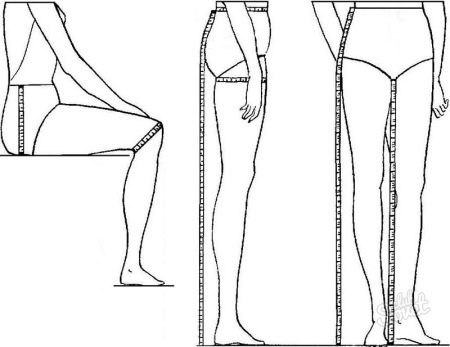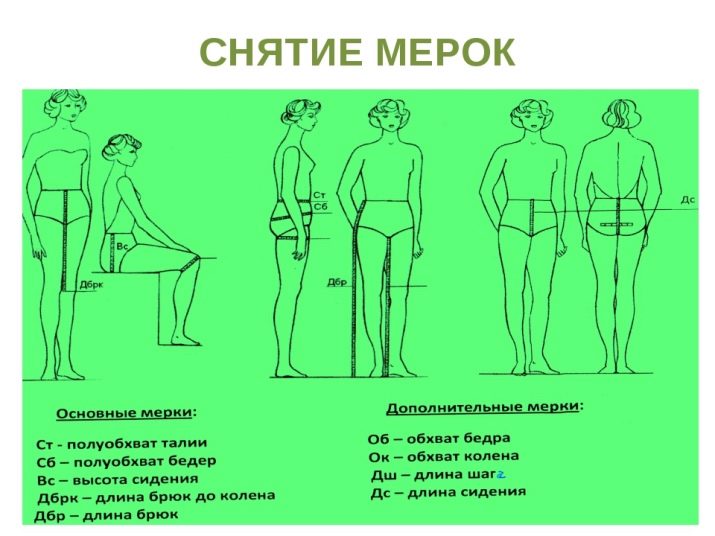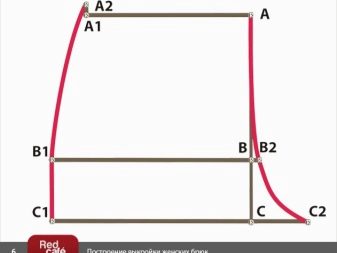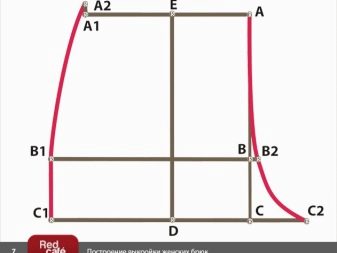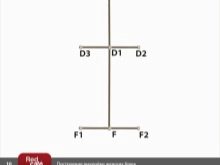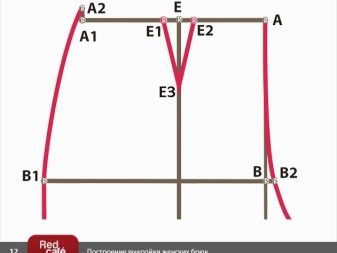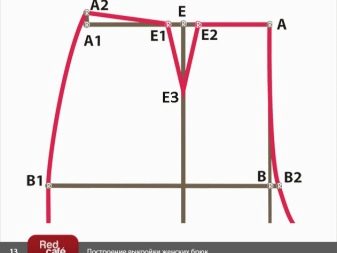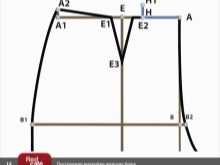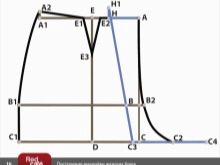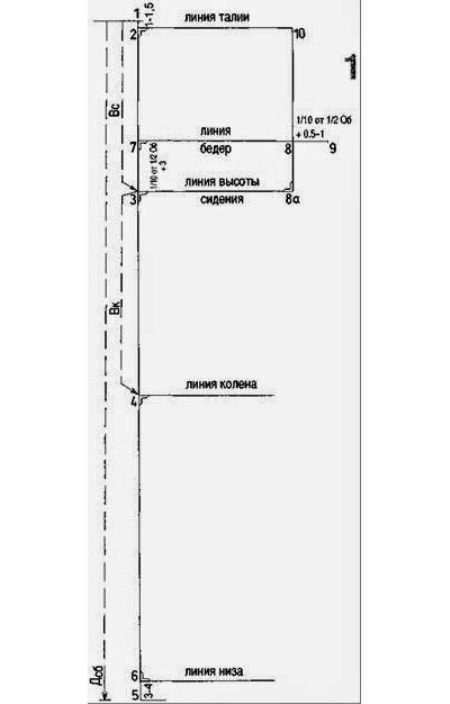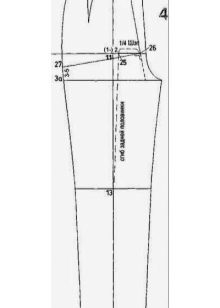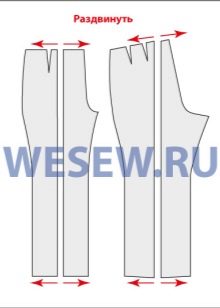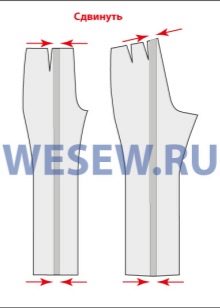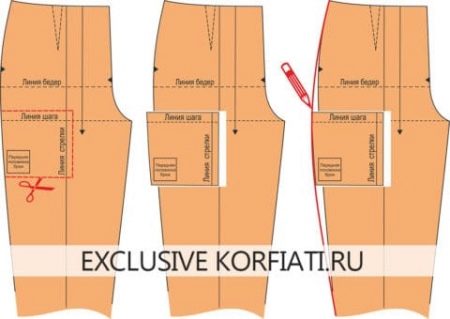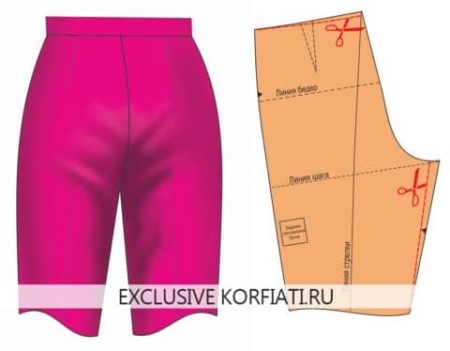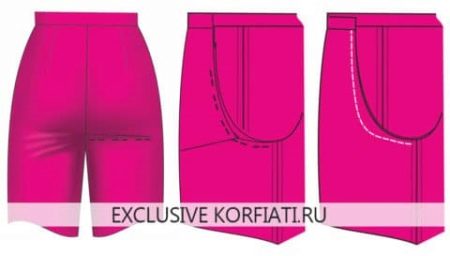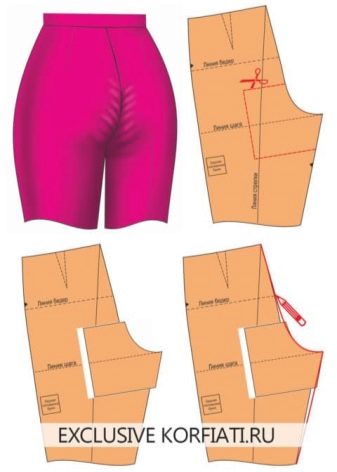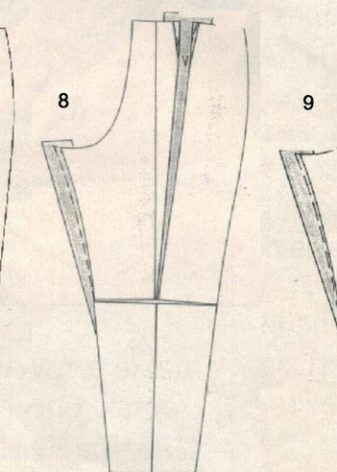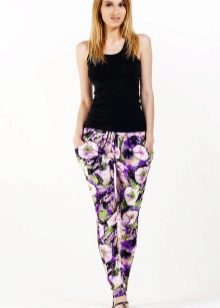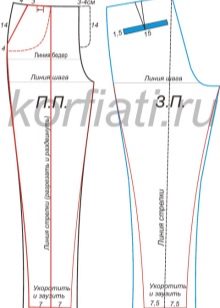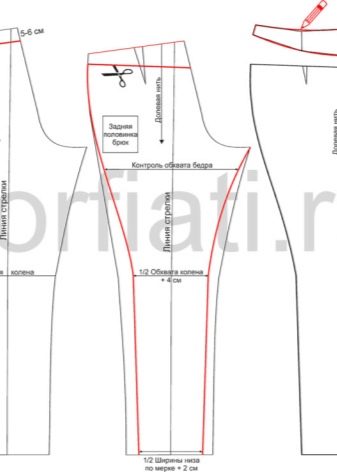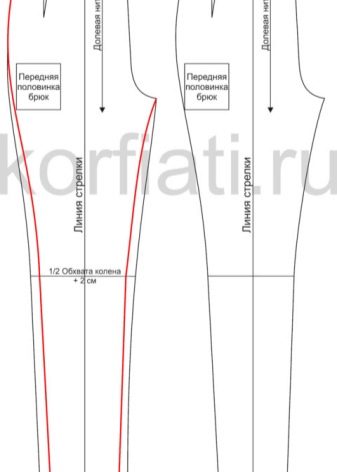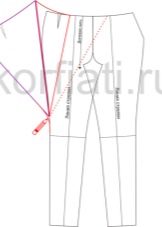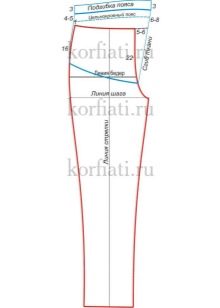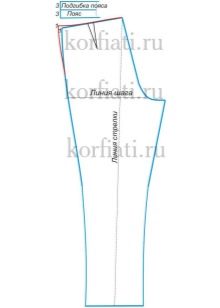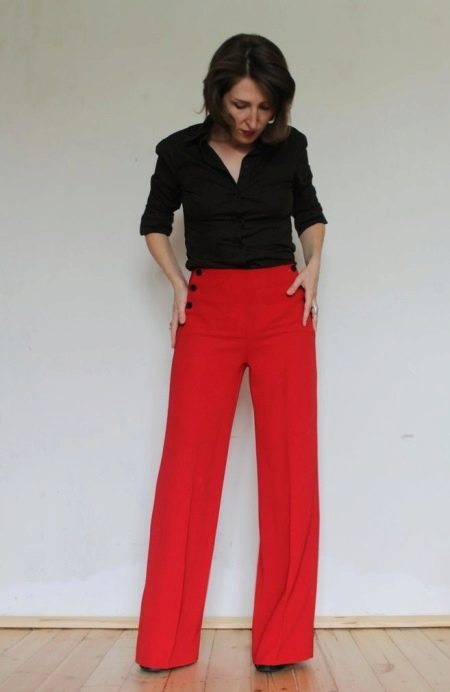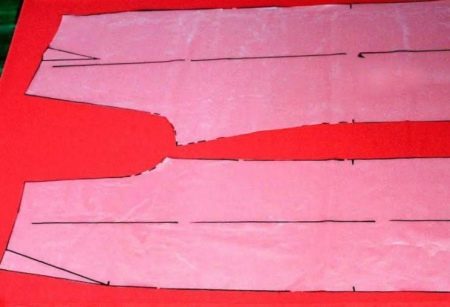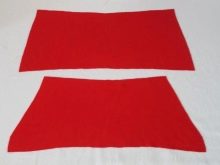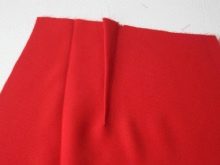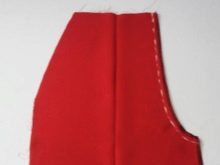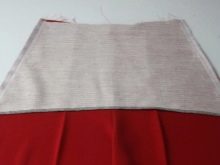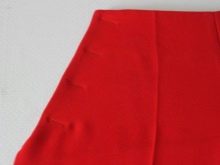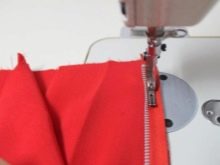How to sew pants with their own hands and where to find the pattern?
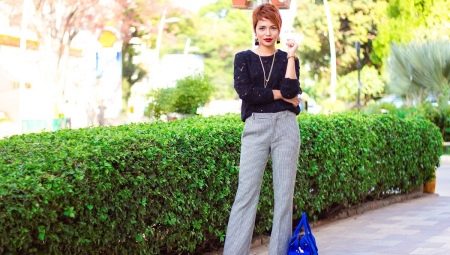
Shopping trips, style choices and models that will fit and sit perfectly, unreasonably high prices in stores — these and many other problems most girls experience. Some give up in search of just their model, others buy for big money, and still others go and buy fabric to sew what is perfect.
What is a base pattern and where can I find it?
To sew a product, a sample is required. This layout is called the pattern.
Pattern - details of clothing, which are made on the basis of the drawing. It consists of several parts, the choice of which depends on what needs to be sewn. It is very convenient to use such a basis for creating small parts.
On one sheet are several patterns. You can find exactly your model using specially marked lines.
Parts that are marked on the base may not always fit perfectly under the figure, which is absolutely normal. In this case, the hostess herself customizes the thing for themselves. The main thing is to take the basis for what is necessary to sew.
Often patterns can be found in specialized magazines, such as Burda, or on the Internet.
Required Tools
To facilitate the work, there are many items for needlework.
When creating trousers use:
- paper for redrawing patterns;
- chalk or pencil;
- needles;
- thread, the desired color;
- tape-centimeter;
- a sewing machine;
- oblique inlay or overlock to cut edges;
- other small parts required by the design of the model: zipper, buttons, elastic and so on.
How to make measurements?
The first thing to start with is taking measurements. To make measurements accurate, do them better in underwear. The main tool at this stage will be measuring tape, with which you need to make measurements:
- waist circumference (at the waist in the narrow part);
- hip girth (wide area);
- side length (spacing on the side of the leg from the waist to the end of the leg);
- seat height (measurements occur while sitting and watching the interval from the waist to the chair seat);
- knee height (on the side from the waistline to the middle of the kneecap);
- stride length (with slightly spread legs measured from the groin of the inner thigh to the floor).
For information on how to properly measure, see the following video.
Drawing techniques
Italian
A step-by-step explanation of trouser sewing is an excellent support for beginning seamstresses.
One of the most accessible is the basic pattern drawing instruction using Italian technology.
This technique is great for sewing trousers for women who have a strong back bend. This problem is solved due to the displacement of the side seam to the center of the back area by 1 cm. Due to this, the model will sit in the belt and on the hips.
This technology deals with the manufacture of straight women's trousers.
First you need to do - take measurements. In addition to the usual measurements to do:
- increase waist;
- increase thighs. Their level depends on how the product will fit.
It is necessary to go from the front panel of trousers:
- Mark A is fixed in the upper right corner from the top. From this point two more marks are held one after the other. From the mark B in the left direction, the line is equal to 1⁄4 (hips circumference + PB) and the mark B1 is made, and 0.5 from B - mark B2.
- To the left of C a thread is drawn that is equal to BB1 - C1. And on the right, 1 \ 20 thigh circumference - C2.
- Now you need to connect A, B2 and C2. There will be an average seam.
- From mark A is carried out and marked mark A1 - 1 \ 4 waist circumference + 3 centimeters. From this tag is held 1 centimeter and denoted by A2.
- Next connect A2, B1, C1.
- In the middle of C1C2, the D mark is placed. From it, the perpendicular to A1A is drawn from the upper portion, and the E mark is denoted. The length of the leg is calculated from the marked mark. This will be the boundary of F.
- In the right and left directions from D1 are lines equal to 1/2 knee circumference. Right mark D3, left - D2.
- Points F1F2 are built on the sides of the F mark. They are equal to the distance of the D2D3 line.
- Now you need to connect the labels C2, D2, F2 - this is an internal seam. At connection C1, D3, F1 an external seam is formed. And the previously made line D, D1, F will be the middle of these two seams.
- To get the front tuck, you need to postpone 1 centimeter from the E mark in both directions and mark these points E1, E2. From the main E mark, go down 10 centimeters and mark E3. Constructed points connect.
- For the front part to be ready, you need to draw lines from A2 to E1, from E1 to E3, from E3 to E2, from E2 to A.
The back side is built on the front part drawing:
- In order not to confuse the lines, use chalk, pencil or a marker of different colors.
- From the line A on the left side, the segment 1 \ 2 AE + 2 centimeters is measured and marked with the mark N. From this mark there is an indent of 2 centimeters and the line marked H1 is drawn.
- Now you need to measure 1 \ 2 girth of the hips and from the point C to the left put C3. Next, make a straight line from this point to H1.
- From C3 make a line to the right, equal to 1/10 of the circumference of the hips, and mark C4.
- Now we should return to the line A. Perform an Italian offset of the side seam: from H to 1/4 waist circumference - 1 centimeter + 2 centimeters and the mark H2 is made. From it, a perpendicular line is drawn up by 1 cm and H3 is put, which connects to H1.
- Next, draw a direction to L. It is obtained by crossing В1В2 and Н1С3.
- In the left part of the mark L is a smooth guide 1/4 of the circumference of the hips to L1.
- To obtain an external seam it is necessary to connect H3, L1. For the formation of the middle seam it is necessary to conduct a segment from L to C4.
- Next, make sections of the knee and bottom on the basis of the rear half. To do this, set aside an increase of 1.5 cm from the marks D2, D3, F1, F2 and label them G, G1, F3, F4. To obtain a back and front seam make a smooth line between L1, G, F3 and C4, G1, F4.
- When forming the undercut on the back, you need to turn to H1H3. In the middle, mark the point M. From it, move 1 cm to both sides and in parallel to H1 L down 14 cm. Formed M1, M2, N.
Complete the pattern by checking the length of the inner and outer seams. If matched, then you can proceed directly to the sewing.
By müller
Among the most simple technologies there is a construction scheme according to Müller. This technique is a construction for beginners.
Pattern is built on a standard model of pants.
- The main base of the drawing is a vertical straight line on which segments 1 and 2 are selected. The length of the segments depends on the shape of the hips. On average, you can measure 1.5 cm.
- Sun is measured by boundaries 1 and 3. VK is marked by points 3, 4. The length on the side of the foot is indicated by marks 1-5.
- 5 and 6 there will be a measurement that corrects the length, the choice of which is subject to the model and the height of the heel.
- Marks 3-7 denote the hips. Next, build straight lines from marks 2, 7, 3, 4, 6 to the right.
- The width of the anterior portion of the pant legs is indicated in paragraphs 7–8. ШШ anterior halves, measured by 1/10 of one-half OB + 1 cm, are fixed in marks 8-9. To get marks 8a and 10 you need to draw a line through the mark 8.
- On line 7-9, you need to find the middle and position the mark 11. Next, you need to mark the segment 6-12. It will correspond to 7-11.
- To get the middle of the front half, you need to form from the waist mark through the marks 13 and 14 at the intersection with the knee and waist marks.
- From 15-16 to make a straight line equal to 4-8 centimeters and mark points 15a and 16a. To align the angles at marks 15a and 16a, you need 7 and 15a, 9 and 16a combine. After that, we get marks 17, 18, 19.
- Row 10-20, defining the deviation of the cut paths of the bow of the front pant region, is 1 cm.
- From mark 8 make a mark in the right direction, 0.5 centimeters long. Through this mark and border 20 lay a straight line. 8a and 8b are equal to half of the segment 8a-17. Next, draw an additional segment 8b-17.
Now you need to make the front line cut:
- From her to make a short cut to the waist. The distance between the intersection of the straight line and the waistline corresponds to 3-5 cm on the right side of the main vertical line. To achieve the desired shape in the border of the knees is to vary the distance between marks 18 and 23 and marks 19 and 24 from 0 to 1 cm.
- The side slice line is formed by a curve using the compound 22, 7, 3a, 23, 15a, 15.
- The line of the step cut is made by connecting the points 17, 24, 16a, 16.
- Segment 14-22 should be divided into two parts, for this it is necessary to hold straight to the mark of the hips.
The back half of the leg is based on the front:
- From point 11 you should make a point 25, for this you need to move 1-2 cm to the right. Next, make a straight line from 25. Distance from this point to the future mark will be 1/4 of the backside width. This point will be referred to as 26. The mid-slice line of the backside is determined by the interval between marks 3a and 27. This segment takes 3-5 cm.
- Next, combine the 26 and 27. From 26 to make the lines in the upper and lower direction.
- The waistline and hips must be increased. At the waist make a path to the left. At the hips to the right and left.
- Move section 26-27 up to the contact with the straight thigh and mark 28-29 there.
- Next, hold 2 straight from the bottom to the knee on both sides of the bend at a distance of 2 cm from each other. Thus, points 31, 32, 33, 33a, 34, 34a are formed.
- For the formation of the mark 35 it is necessary to draw a line from the mark 32 through 29 to the contact with the waist section.
- Mark 31 merge with 30. Depending on the gluteal forms, make the interval between the marks 13 and 36 equal 13-35 minus 0-1 cm. 35-36 merge with each other.
- From mark 36 to make a segment with a distance of 0.5-1cm in the left direction to 36-35. Thus, the mark 37 is obtained. At this stage, you can proceed to the design of the upper limit of the middle slice of the pants. For this you need to combine 37 38. The range between these marks will be equal to 1/4 of the waist circumference + 3-4 cm + 0.5 cm.
- Next, draw a line from 38 to the top. Here also draw the border of the side slice of the backside. This length is equal to the length of the front area of the pants.
- Need to draw tuck. It should be marked on the rear part perpendicular to the line 36-35. The length should be 13-15 centimeters.
- At this stage it is necessary to form threads of a step cut and a waist. The lengths of the stepping cut back and front should be equal. Should proceed to the design of the middle cut.
In this case, the step is considered the comparison of two parts, the adjustment of the cutoff waist and tucks.
How to increase the pattern to the desired size, how to reduce?
Finished patterns are always made in accordance with the standard figure. But do not be upset, because you can increase or decrease to a specific size.
You should carefully inspect the back and front trouser legs and cut along the vertical line in the middle and move them apart by 0.5-1 cm to increase. To reduce the details move 0.5-1 cm.
To increase the length of the pattern, it is necessary to add a bottom 2-3 centimeters. For how this is done, see the video.
Perfect fit pants: adjustment rules
Perfect pants are their perfect fit, able to hide figure flaws and correct them somewhere. But hand-sewn trousers do not always match the ideal. To do this, refer to the adjustment rules.
Usually problems arise with the hips. For example, if the girl has full hipsthen it promotes wrinkling. To get rid of wrinkles, you can slightly work on the pattern.At the front of the trousers, it is necessary to make two pieces 10-15 centimeters above the step margin by 2-3 cm and 10 cm below. Next, compare the result. By marks cut. The resulting part is placed in the left area by 1-3 centimeters and mark this border side. The same must be done with the rear section.
With thin legs the image of bagginess is created. To avoid this, it will allow the removal of excess volume. It is necessary to measure the top of it and compare the resulting figure with the value on the pattern. Next, calculate the difference between the two digits, and set aside 1/4 of the calculated value along the lateral and stepped back and front areas and thereby shorten the width of the pant leg at the top of the leg circumference.
With insufficient buttocks a large amount of material is formed. To adjust, you need to reduce the border of the waist to the desired value and at the back of the area to reduce LH.
To get rid of the folds under the buttocks, you must work with ready-made pants:
- On the finished product you need to stab the excess fabric in one fold on one of the legs from the side seam to the middle. This fold must be removed.
- Next, you should cut the middle seam in the area from the stepping line to the belt.
- Next, connect the two legs to the outer parts.
- When comparing the surplus on a non-chopped leg, it should be moved upwards along the middle seam.
- The new border should be moved to the other half of the belly below.
- Next, sew the middle seam on the new line, and cut off the excess in the seam allowance. And the excess in the length of the belt to remove.
In the reverse situation - serving gluteal zone, folds and creases form in its lower part. To correct this problem, it is necessary to measure on the back of the pants 11 cm from the step line to the upper and lower sides and draw 2 parallel 12-15 centimeters each. Their ends then merge. According to the resulting features cut the pattern. Cut off to the right literally 1-3 cm and create segments for the middle seam of the back and pitch.
Basics of modeling
Low waist
Modeling makes it possible to create perfect pants, taking into account all the special shape. All models are based on the standard pattern of trousers.
- Before you start modeling a version with a low waist, you need to move away from the waist by 2 cm on both sides. After it is necessary to make a new understated border and cut along it.
- When you create the front of the narrowed model, you first need to narrow the pants down to about 14 cm. Focusing on your height, shorten it to the desired size. Next, you need to determine the area of entry into the pocket. To do this, measure 4 cm to the right at the waist and down 14 cm. The resulting groove must be transferred to the fold. For lightning need an increase of 3-4 cm in width and in length by 14 cm.
- For additional volume in the area of the thighs and the second fold, you need to cut the pattern along the line of the arrow and move it 4 cm apart.
- To create the backside of the pants, you need to narrow it down by 15 cm and reduce it. In the width of the rear leg reaches 1-2 cm.
With smell
Creating trousers requires the formation of a back lobe:
- Therefore, you should measure 5 cm down from the waist and spend a low cut.
- Coquette draw from the already updated contour of the waist. Its parts should be cut, cut into the grooves and glue everything together. Its top and bottom should be rounded.
- The narrowing of the legs at the bottom and in the knee is also dependent on personal desires.
- When modeling the front, you should reduce the waistline by 5-6 cm. Next, narrow down at the knee section and lower. Draw the lines of two seams: side and stepped. Next translate before tracing twice. The two halves lay down on the middle line of the front.
- To continue the simulation, set aside in the left direction 5 cm from the sideline, down 14 cm.
- To create the smell you need to break in front of the waist segment in half. From the area of the knee, retreat 10 cm upwards and the created marks combine with a dash. From the resulting create a strip of smell.
- All the details of red and lilac color must be reshoot on tracing paper. The red triangle is mirrored in the left area. Lilac detail must be combined with a triangle of red.On the sideline and the waistline, all are straight and the corners are rounded.
- Additionally, make two belt details 5 cm wide and in length corresponding to the length of the upper part of the trousers.
For pregnant
For the production of pants for pregnant women in front along the side border from the waist it is necessary:
- Move 16 cm down and to the left 1 cm.
- Up you need to postpone a segment of 4-5 cm.
- At the middle line, the front should be measured down 22 cm and to the right side to continue the waist by 5 cm. Connect all marks straight and then bend them along the pattern.
- From marks 5 and 6 you need to move up about 6-8 cm. Here you need to make a new waist with a belt.
- At the hem of the belt must be added up to 3 cm.
- You should also prepare a stitched belt for the back of your pants. Its width corresponds to 6 cm and a length of 3 cm.
For full
Production of pants for the full begins with the pattern before:
- On the vertical segment to postpone the height of the seat (points 1-2), VK (1-3), DB (3-4), create the desired length (1-5), half-grip hips + 3 cm (5-6) and line hips ( 3-7), the width of the front half (7-8), half-grip hips + 1.5 cm (8-9).
- On marks 2, 3, 4, 7 make a segment. To the area of the hips from mark 8 to make a perpendicular. In contact with the sun and waist mark 8a and 10.
- From mark 12 make a straight line through 11. When crossing the marks of the knee and waist put 13 and 14.
- From 12 measure to the upper region 4-8 cm and mark 15a and 16a. Marks 7 and 15a, 9 and 16a combine. Against this background, make 3a, 17, 18, 19.
- From 8 in the right direction, measure 0.5 cm. Half of the segment 8a-17 measure from 8a upwards and thus 8b. The resulting mark combine with 17.
- Mark 21 is formed from 10 by deposition of 1/4 OT + increase on the tuck and free fit. If the upper edge straight to the waist to move away by 1.5 cm, then formed 22.
- Within the limits of the knee from the ends, measure 1 cm in the inner side - marks 23, 24. mark the segments of the lateral and stepping cut.
- The groove should be built to a depth of 10 cm and a solution of 1.5 cm. At the end, complete the creation of the waist.
When converting the back side, you must copy the front half and add corrections:
- Measure the area of the back fold from mark 11 by 1-2 cm. From 25 to make the width of the back half - 0.5 cm. Sign 27 is formed by deposition of 3-5 cm from point 3a. Mark 26 and 27 close.
- Hips and waist line should be increased. Width of the rear leg to produce from 28 to contact with the thigh.
- 31, 32, 33, 33a, 34, 34a are made by holding side and step slats in two cm from the front slice.
- The path from 32 through 29 to the waist creates a mark of 35. 35 connect with 36 and put in the left direction 1 cm. So it turns out 37. From this point measure 1 \ 4 waist circumference + 3-4 cm tuck + 0.5 cm of increase in free fit . There is a point 38.
- It is necessary to move the side cut lines of the front side to the side cut part of the rear half.
- The groove is constructed at a length of 13-15 cm. At the end, you must complete the waist area of the middle section of the rear section of the trousers.
How to sew your own hands?
Many girls with apprehension are taken for tailoring trousers, considering this product difficult. One thing that is difficult is possible. Need to start with the yardstick. In order for the pants to fit perfectly on the figure, it is necessary to take measurements correctly. Measurements should be made from a naked body. Measuring tape tightly to the body.
By your standards, you can begin to build a pattern. When creating a pattern using their own measurements and values that were obtained using calculations by own measures.
Once the base pattern is ready, you can start modeling. To do this, choose a model of pants or trousers and use the samples already prepared in magazines and the Internet to create your own style.
After you need to choose a fabric. All materials with elastane are suitable for trousers. You can also use wool, satin and linen.
Before sewing it is recommended to stroke the fabric.
It remains to cut out the details and sew.




